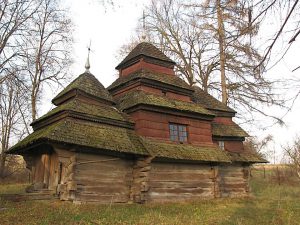
Interview with Myron Stachiw
Historical and architectural consultant specializing in the study, documentation, and interpretation of historic structures and properties. Among his employers and clients have been the Museum of American History, Smithsonian Institution; Old Sturbridge Village; Colonial Williamsburg Foundation; The Society for the Preservation of New England Antiquities; Rhode Island Historical Society; Massachusetts Historical Commission; Rhode Island Historic Preservation and Heritage Commission; Connecticut Trust for Historic Preservation; The Ukrainian Museum (New York City), and others.
Why did Yuri Yanchyshyn and you decide to organize the workshop?
Yuri and I are engaged in a multi-year project to support and help the Department of Architecture and Conservation of the Lviv Polytechnic National University in Lviv, Ukraine, to expand and improve their architectural conservation program from stone and artificial stone conservation to also include wood and painting on wood, as well as to expand into the conservation of other objects of Ukraine’s very rich cultural heritage. I am an archaeologist, architectural historian, and educator by profession, with long engagement with historic preservation; Yuri is an experienced and respected professional conservator of fine furniture and other art objects. In 2017, and again in 2019-2020, Yuri was awarded a Fulbright fellowship to teach wood conservation in the Department of Architecture and Conservation of the Lviv Polytechnic National University.
The 2019 workshop is the first of what is hoped will be annual workshops held in Ukraine to teach students and young professionals in the fields of architecture, preservation and restoration, and conservation the latest theory and methods of conservation assessment, documentation, and treatment planning. Each year the immersive workshops will focus on historical buildings in Ukraine which are in need of preservation, conservation, and restoration.
How do you collaborate with the Lviv Polytechnic Institute to offer the workshop?
Our collaboration started back in 2017 when Yuri received a grant from the Shevchenko Scientific Society in the USA to allow the director and Deputy Director of the Department of Architecture and Conservation of the Lviv Polytechnic National University to come to the U.S.A. for an intensive two-week tour of some of the leading conservation laboratories and academic conservation programs. The goal was to introduce them to the current state of conservation practice and education in the U.S. and also to introduce the U.S. conservation community to the richness of Ukrainian historical cultural heritage and the very pressing needs for conservation of this heritage.
The workshop is sponsored by the Department of Architecture and Conservation of the Lviv Polytechnic National University. Students enrolled in the School of Architecture and the Department of Architecture and Conservation will be participants in the workshop, and the Department’s faculty will serve as lecturers and instructors. University facilities will be used as classrooms
Who is the target audience for the workshop? Is it designed for Ukrainian students to master architectural conservation practices or foreign students interested in Ukrainian history and art?
The workshop is open to students and recent graduates of art and architectural conservation programs, programs in historic preservation, art and architectural history, as well as young professional in those fields. The program is open to participants from Ukraine as well as from other countries. This first year enrollment includes mostly Ukrainian students and a young professional conservator from Kyiv, as well as a young professional conservator from Croatia. Announcement for the workshop were posted internationally, and inquiries were received from students enrolled in academic conservation programs in the UK and Egypt.
Why did you select the Church of the Theophany (Bohoyavlennya Hospodnyoho) in the village of Kuhayiv as the site?
In 2013 UNESCO approved the designation of 16 Ukrainian wooden churches in the Carpathian Mountain region of Ukraine and Poland to the UNESCO World Heritage List of Cultural Heritage. Currently approximately 3000 wooden churches dating from the 16th century to the early 20th century survive in Ukraine, and many are in need of conservation and restoration.
The small wooden church in Kuhayiv, erected in 1693, is a perfect candidate for the workshop. Several decades ago the congregation erected a new, larger, masonry church nearby the old log church, but continued to maintain and preserve the old church with its surviving 18th century iconostatis. Unfortunately, maintenance of the roof and other features critical for the continued survival of the building were not adequately sustained, and the log structure began to deteriorate. A local preservation organization, the Lviv Foundation for the Preservation of Architectural and Historical Monuments, has begun efforts to preserve the church building and has arranged for the workshop as a means to guide their future preservation work on the structure. The village of Kuhayiv is only about 10 km from Lviv, and so a convenient site for the first architectural conservation workshop.
What are anticipated outcomes of the workshop?
The goal of the workshop is to expose students to contemporary international theory, methods, practices, standards, and ethics of conservation of cultural objects. It will encompass the assessment of wood as the primary material of this art and architectural form, as well as the paintings on timber walls, the iconostasis and icons. This assessment will take the form of a highly detailed condition report and recommendations for conservation treatment where appropriate, to which all attendees will contribute. In addition to the assessments, participants will visit a conservation studio conducting the conservation of a 17th century iconostasis; visit and tour other sites; and will attend lectures / seminars by U.S., Ukrainian, and international practitioners in the field on the history of the wooden churches and their interiors, wood and its properties, wood identification, construction methods, documentation procedures, preservation issues, and other topics.
Additional details regarding the workshop can be found at https://www.periodfurnitureconservation.com/workshop
